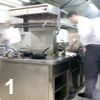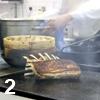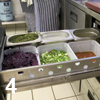My new kitchen: Mark Page, head chef at London's Commonwealth Club
Mark Page is a lucky man. As head chef at the Commonwealth Club in London's Northumberland Avenue, he doesn't have just one shiny new cooking suite, but two. Both manufactured by Charvet, the suites are part of a £300,000 refurbishment of the club's two kitchens which has seen them double in size.
The club is owned by the Royal Commonwealth Society and has 6,000 members, male and female, about two-thirds of whom use the facilities on a regular basis.
There's a lounge bar which is used morning and afternoon for coffee, made in a San Marco manual espresso machine, and where tapas is served for lunch and Champagne is quaffed in the evenings. Eleven spaces, including the glass-walled dining room and two vault rooms on the lower ground floor, can be booked by external clients, and there are plans to turn the mezzanine bar into an internet café.
About eight functions a day are catered for, varying in size from just four or six to 160 or even a canapés party for 600.
The restaurant is for members only and does about 100 covers a day, split evenly between lunch and dinner. Because there are members who dine at the club several times a week, the menu changes every Wednesday. A three-course lunch costs £20 from an à la carte menu featuring dishes such as seared carpaccio of Szechwan tuna, wasabi and kohlrabi salad, and thyme-roast red mullet, saffron new potatoes and tapenade.
Club manager Shaun Whitehouse joined the team two-and-a-half years ago and was amazed at the amount of business being done from the existing kitchens, installed in 1998 when the club reopened. "You had to be one seriously organised chef to do that amount of business from those kitchens," Whitehouse says. "It's a testament to Mark's organisational skills."
Page has been at the helm of the club's two kitchens - one for functions and the other for the restaurant - since the reopening and has a brigade of 12 chefs. "We suffered from a sheer lack of space, firepower and fridge space," he says. "We had just six burners downstairs, and used to have to queue to get on them, but the biggest struggle was doing weddings for 220 and having no space to plate - we had to do it in a corridor."
With the decision made that more space was needed for the kitchens to be more productive, Whitehouse and Page got together with Noel O'Dwyer, of project management company Mellersh & Harding, to design the layout of the new spaces. The installation was carried out by Crane Catering, which holds the maintenance contract for all the club's catering equipment.
In response to Page's need for greater firepower, two Charvet suites were specified, one modular and one bespoke, but both designed by Charvet's UK sales manager, Colin Leonard. Extraction was a niggle because the ducting was already in place, so this dictated the positioning of the cooking suites - not exactly where Page wanted them.
The modular suite replaces the six-burner range in the function kitchen on the lower ground floor. It has three ovens, five solid-tops, four burners, a salamander, a boiling kettle, and a bratt pan for stocks and braising. Page chose solid-tops in preference to open burners, since he can fit more pans on them. An existing twin-basket fryer and tandoori oven were slotted on the end.
Upstairs in the restaurant kitchen is the bespoke suite. It needed to fit into a very narrow space, and Page was insistent that he have an island suite rather than a linear one against the wall. Two chefs work on either side, one side dedicated to starters and the other covering meat, fish and garnishes.
On each side, there is a solid-top and a plancha for cooking meat and fish (but which can also take pans, like a solid-top). There's a salamander to share at one end, underneath which is an area perfect for plating up or for holding sauces when they're moved off the solid-tops.
Two ovens pass through the entire width of the suite, with access from both sides. The symmetry ends at the opposite end to the salamander, where the starters section has a single burner and, for garnishes such as tempura veg, samosas and deep-fried courgette flowers, there's a twin-basket fryer.
Refrigeration was a big issue in both kitchens. Basically, there wasn't enough of it. Several existing Williams upright cabinets were kept for pastry items and bar food. Both kitchens benefit from a bank of new Foster undercounter refrigerators located opposite the cooking suites, and whose surfaces serve as prep areas. A large Foster coldroom sits at the back of the function kitchen and leads into a walk-in freezer. Page estimates refrigeration capacity has trebled at least.
There's a separate room for dishwashing, with another lift for dirties and a bespoke Winterhalter machine.
Another new toy is a floor-standing Robot Coupe ice-cream machine - necessary for the volume of ice-cream needed. Flavours made include vanilla; lemon grass; chilli and chocolate; and, recently, a rooibos sorbet for a South African function.
The brief When the building adjoining London's Commonwealth Club came up for grabs, club manager Shaun Whitehouse was keen to expand the private members' club facilities into the extra space. But the extra business that the creation of new meeting rooms would generate would also mean more work for the already stretched kitchens. So there was only one thing to do - make them bigger.
1 The Charvet bespoke range cost £34,000 and is 3,500mm long, 1,200mm across and 900mm high. The top is one-piece 3mm-thick stainless steel (with titanium to help heat-retention). The Charvet salamander, open on three sides, heats to maximum temperature in 30 seconds and, with a 12kW rating, there's no need to keep it alight all the time.
2 The two smooth gas planchas measure 680mm x 400mm, are made of 20mm-thick cast iron, and have a grease channel on all sides. Each is rated at 8kW and independently controlled. The two solid-tops each have a plate size of 750mm x 450mm and are rated at 11kW. Each has a cast-iron burner with a brass ring, and heat-conducting fins underneath that give high heat over the ring and gradual cooling towards the edges, allowing for rapid boiling/reduction and simmering. Each solid-top has a one-piece moulded cement base that allows more efficient heating of the tops.
3 One of the most exciting arrivals for Page was two Rational combi-ovens (he has never had one before) for the function kitchen, allowing new cook-chill plans for large functions.
4 Some of the Foster undercounter refrigerators have doors and others have drawers, such as the one used to house main-course ingredients in the restaurant kitchen - one dish per drawer. A Cool Sense fridge monitoring system by Cornerstone Systems records all fridge, freezer and dishwasher temperatures, and gives a print-out every hour to aid HACCP compliance.
5 The restaurant kitchen was deemed too hot for a pastry area, so desserts such as baked sweet ricotta, and chocolate and orange ravioli - along with about 20 daily servings of bar food such as risotto Gruyère crocottes, sun-dried tomato dressing - are sent upstairs from the cooler function kitchen, where they are prepared, via a food hoist.
Contacts
- Charvet, 01342 717936
- Cornerstone Systems, 01785 818020
- Crane Catering, 01883 652045
- Foster Refrigerator, 01553 691122
- Mellersh & Harding, 020 7499 0866
- Rational, 0800 389 2944
- Robot Coupe, 020 8232 1800
- Commonwealth Club, 020 7930 6733
- Williams Refrigeration, 01533 817000
- Winterhalter, 01908 359000












